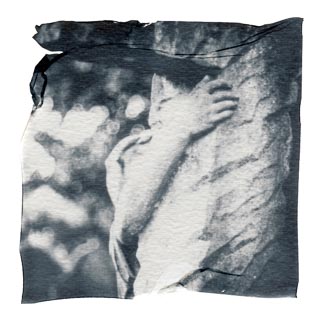Secret Gardens of the Dead (ARPS)
In September 2019 I was awarded a Royal Photographic Society Associateship distinction in the Contemporary and Conceptual category. This involves writing a statement of intent (of up to 300 words in the Contemporary and Conceptual category) and creating a portfolio of 15 photographs that responds to it. My statement of intent and some background information is at the end of the page. This was followed in November 2020 with an RPS Fellowship distinction a for another portfolio of Polaroid emulsion lift prints called Polaroid Waterscapes.
+ Statement of intent, hanging plan and background information
Statement of intent
London’s ‘Magnificent 7’ cemeteries were built between 1832 and 1841 in what were then semi-rural locations. They became known as garden cemeteries due to their lush and verdant landscaping surrounding sometimes very grand chapels and mausolea for the great and the good.
Amidst London’s unrelenting growth much of that grandeur has faded and crumbled, and many of these cemeteries have become mysterious tangles of green surrounded by dense urban development.
As you push through the undergrowth and stumble upon a crumbling chapel or beautiful but decayed piece of sculpture it's easy to convince yourself that you have found something that has lain forgotten and unseen for decades. I wanted to capture this feeling by creating prints that give the viewer a veiled, fractured window to another time, a hidden world… a secret garden of the dead.
(136 words)
Hanging plan
 The hanging plan is a very important part of an RPS distinction submission. Your prints will be carefully hung according to your hanging plan before being assessed. It is essential that the prints create a harmonious whole. If you are viewing this page on a large screen they will appear above according to the hanging plan (3 rows of 5 images), but if you are viewing this page on a tablet or phone with a small screen you can see an image with the correct hanging plan here.
The hanging plan is a very important part of an RPS distinction submission. Your prints will be carefully hung according to your hanging plan before being assessed. It is essential that the prints create a harmonious whole. If you are viewing this page on a large screen they will appear above according to the hanging plan (3 rows of 5 images), but if you are viewing this page on a tablet or phone with a small screen you can see an image with the correct hanging plan here.
Background information
I produced these prints using a process called Polaroid Emulsion Lift. This process involves taking a normal Polaroid print, trimming off the white border, separating its two layers and putting the layer containing the layer of emulsion chemicals with the image in a tray of hot water. After a couple of minutes the emulsion layer will float freely in the water.
A piece of plain watercolour paper is then placed in the water under the emulsion layer and lifted out of the water so the emulsion layer sticks to it. While the paper is still wet the emulsion layer can be flattened out with a brush, but there will always be folds, tears and wrinkles produced by the action of the water. I felt this process gave the images a fragility which suited the artistic intention.














